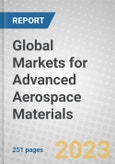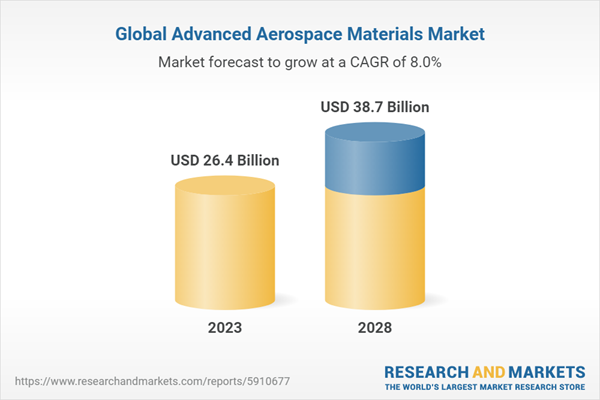This report examines the emerging materials in the aerospace industry. Definitive and detailed estimates and forecasts of the global market are provided, followed by a detailed analysis of each material, application and regions. The report also focuses on the regulations, relevant industry organizations and government-supported programs impacting this market. Regionally, the focus of the study will be the markets of the Americas, Europe and Asia-Pacific. The publisher has not considered the rest of the world in its research scope because the major contributions and developments in emerging materials in the aerospace sector is from the Americas, Europe and Asia-Pacific only.
The scope of the advanced aerospace materials industry is continually expanding as new discoveries are made and as researchers and industries explore innovative ways to harness the unique properties of advanced materials and manufacturing technologies. This report, however, concentrates on emerging materials that are currently in commercial use or are likely to be commercialized by 2028. Other applications that, while promising, are not likely to make it out of the laboratory by 2028 are not covered in depth. Sales value estimates are based on prices in the supply chain. Market-driving forces and industry structures are examined. International aspects are analyzed for all global regions.
This study reviews the following material categories, along with relevant market and production information, technological descriptions and issues, key applications and major market factors.
This report organizes material type into the following segments -
- Advanced steel alloys.
- Advanced aluminum alloys.
- Titanium alloys.
- Superalloys.
- Advanced composites - CFRP, GFRP.
- Ceramic-matrix composites.
- Advanced adhesives.
The following applications for advanced aerospace materials are also examined, with market breakdowns for each by region -
- Commercial passenger aircraft.
- Commercial transport aircraft (for cargo).
- General aviation.
- Helicopters.
- Defense industry and government.
- Commercial space industry.
There are several technologies of interest - including those that could someday capture significant market share - that have not yet developed to the point of achieving significant market share. Listed below are some technologies that are similar to the target materials but do not meet the definition of advanced aerospace materials considered in this study.
- Conventional steel plate, carbon steel and other conventional metals that are used in some cases for basic structural elements.
- Carpeting, vinyl, foams and other non-structural cabin elements that use conventional materials.
Pure aluminum (only aluminum alloys are considered in this study).The market analysis completed in support of this study was developed over two phases. The initial phase of the analysis included a review of each of the advanced aerospace materials under study, as well as a review of the industry trends and factors likely to impact or affect their market development and growth potential. Regional markets were in many cases variable for this study. In the second phase, the focus of the analysis was on sales of advanced aerospace materials with respect to a specific end use. Market calculations were originally developed based on trade volumes for each of the categories considered, to the extent that this data was available. Market values were then developed using typical pricing for each of the advanced aerospace materials categories that were considered.
Within this framework, it should be noted that the study did not consider the ultimate final end-product value. For example, the publisher do not quantify the value of an airplane that is sold by Boeing to American Airlines. Instead, we consider the value of the specific relevant materials that are included in the airplane, based on their purchase cost by Boeing. The market values shown are normalized to 2022 U.S. dollars, and they discount the effects of past or future inflation on market values.
Once the initial technology-level data was developed, application-level data was cross-referenced against the technology data. Applications were also investigated based on future anticipated deployment and potential for changes in leading and secondary technologies over time. We further developed country-level splits based on a combination of regional and national level sales and revenue data. In some cases, country-level splits were estimated for segments where national-level data was limited or unavailable. All estimates were completed based on the available technology and application-level data, and then benchmarked against other data collected, where available.
Report Includes
- 62 data tables and 66 additional tables
- An overview and up-to-date analysis of the global markets for advanced aerospace materials
- Analyses of the global market trends, with historical market revenue data (sales figures) for 2022, estimates for 2023, and projections of compound annual growth rates (CAGRs) through 2028
- Estimate of the actual market size and revenue forecast for the global advanced aerospace materials market, and corresponding market share analysis based on type, application, and region
- In-depth information (facts and figures) pertaining to the market growth drivers, opportunities and challenges, upcoming technologies, future prospects, industry regulations, and the impacts of macroeconomic variables
- Analysis of market growth opportunities with a holistic review of Porter’s five forces model and PESTLE analyses considering the micro
- and macroeconomic factors prevailing in the market
- Discussion of sustainability trends and factors in emerging materials in the aerospace industry, with emphasis on consumer attitudes, ESG score analysis, future of ESG, and the ESG practices followed
- Review of both new and existing patents on emerging materials in the aerospace industry
- An overview of the major vendors in the worldwide market for advanced aerospace materials along with an analysis of the structure of the industry, including company market shares and recent mergers and acquisitions (M&A) activity
- Profiles of the leading global corporations
Table of Contents
Executive Summary
The emerging materials in the aerospace market is anticipated to continue its growth trajectory, driven by advancements in research and development, increased adoption across the aerospace industry, and ongoing innovations in materials and processes. Global governments, academia and industries are investing in emerging materials, which indicates a solid commitment to its development. The demand for lightweight, high-strength, sustainable and technologically advanced materials is driven by the pursuit of greater fuel efficiency, improved safety and environmental sustainability. Stringent emissions standards are compelling the aviation industry to develop materials and technologies that significantly reduce carbon footprint.One of the exciting initiatives for global advanced aerospace materials is NASA’s Advanced Materials Initiatives, which explore the development of advanced materials in space exploration. This includes materials for spacecraft, habitats and spacesuits designed to withstand the harsh conditions of space. Currently, NASA is seeking concepts from the U.S. industry to develop advanced materials and products in space that could benefit life on earth and grow the low earth orbit economy. In addition, a European research and innovation program called Clean Sky 2 is devoted to creating and advancing cutting-edge technology for a more environmentally friendly aviation sector. It is an extension of the original Clean Sky program and a component of the Horizon 2020 Framework Program. The principal initiative for research and innovation in the European Union focuses on reducing carbon dioxide (CO2) and nitrogen oxide (NOx) emissions.
Using additive manufacturing technology opens up possibilities for complicated geometries, unique components and rapid prototyping. It lowers material waste and streamlines production. These innovations in materials that can withstand the rigors of space travel boost interest in space exploration and hypersonic flights. They also represent growth opportunities in developing advanced ceramics, CMCs and high-temperature alloys.
Companies Mentioned
- 3M Co.
- Alcoa Corp.
- Ametek Inc.
- Arconic
- Aubert & Duval
- Basf Se
- Beijing Beiye Functional Materials Corp.
- Carpenter Technology Corp.
- Doncasters Group
- Dupont De Nemours Inc.
- Fort Wayne Metals
- Haynes International Inc.
- Hexcel Corp.
- High Performance Alloys Inc.
- Materion Corp.
- Novelis
- Rolled Alloys Inc.
- Solvay S.A.
- Special Metals Corp.
- Teijin Ltd.
- Toray Industries Inc.
- Vdm Metals Gmbh
- Vsmpo-Avisma
Table Information
| Report Attribute | Details |
|---|---|
| No. of Pages | 251 |
| Published | November 2023 |
| Forecast Period | 2023 - 2028 |
| Estimated Market Value ( USD | $ 26.4 Billion |
| Forecasted Market Value ( USD | $ 38.7 Billion |
| Compound Annual Growth Rate | 8.0% |
| Regions Covered | Global |
| No. of Companies Mentioned | 23 |









